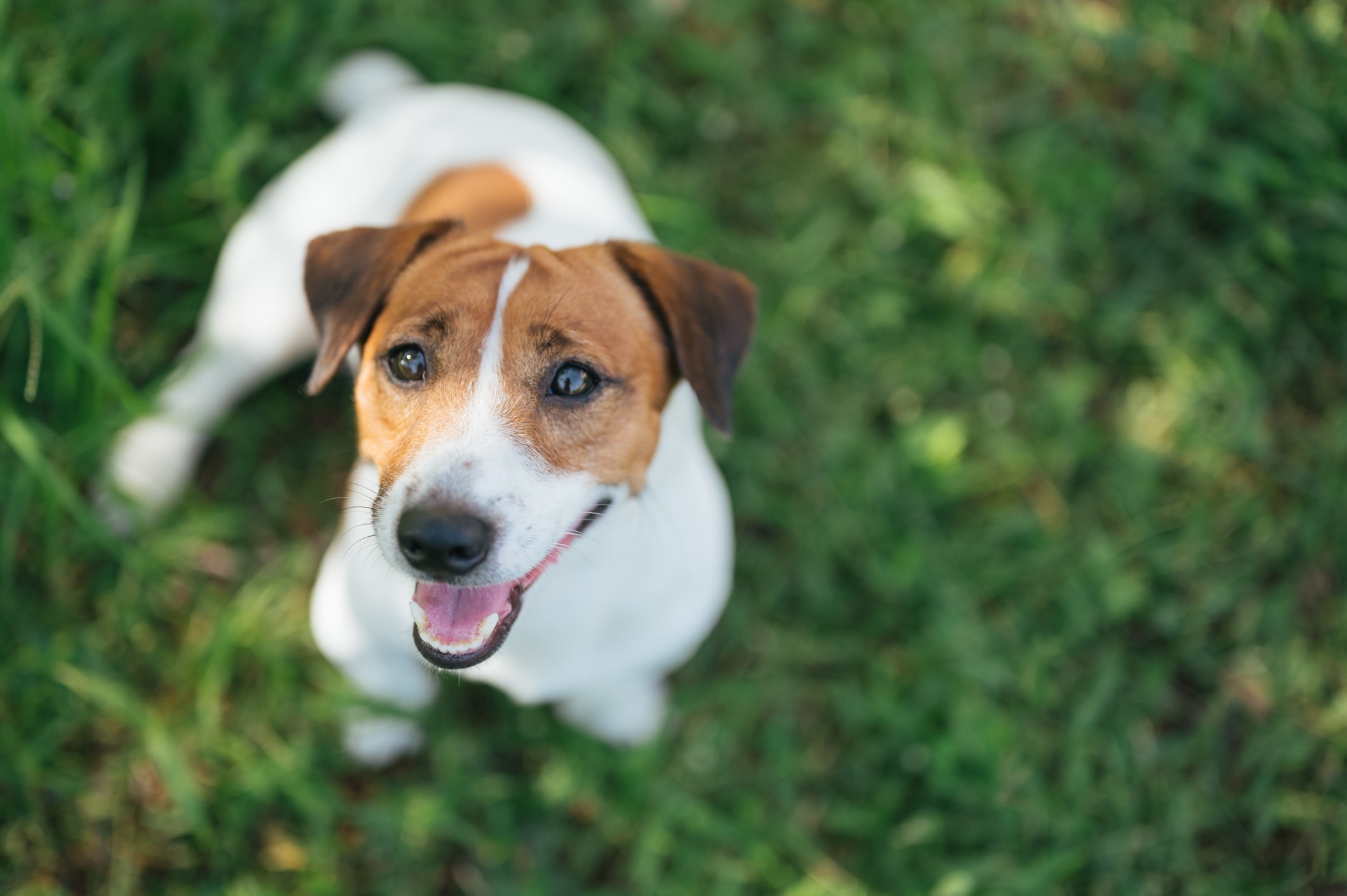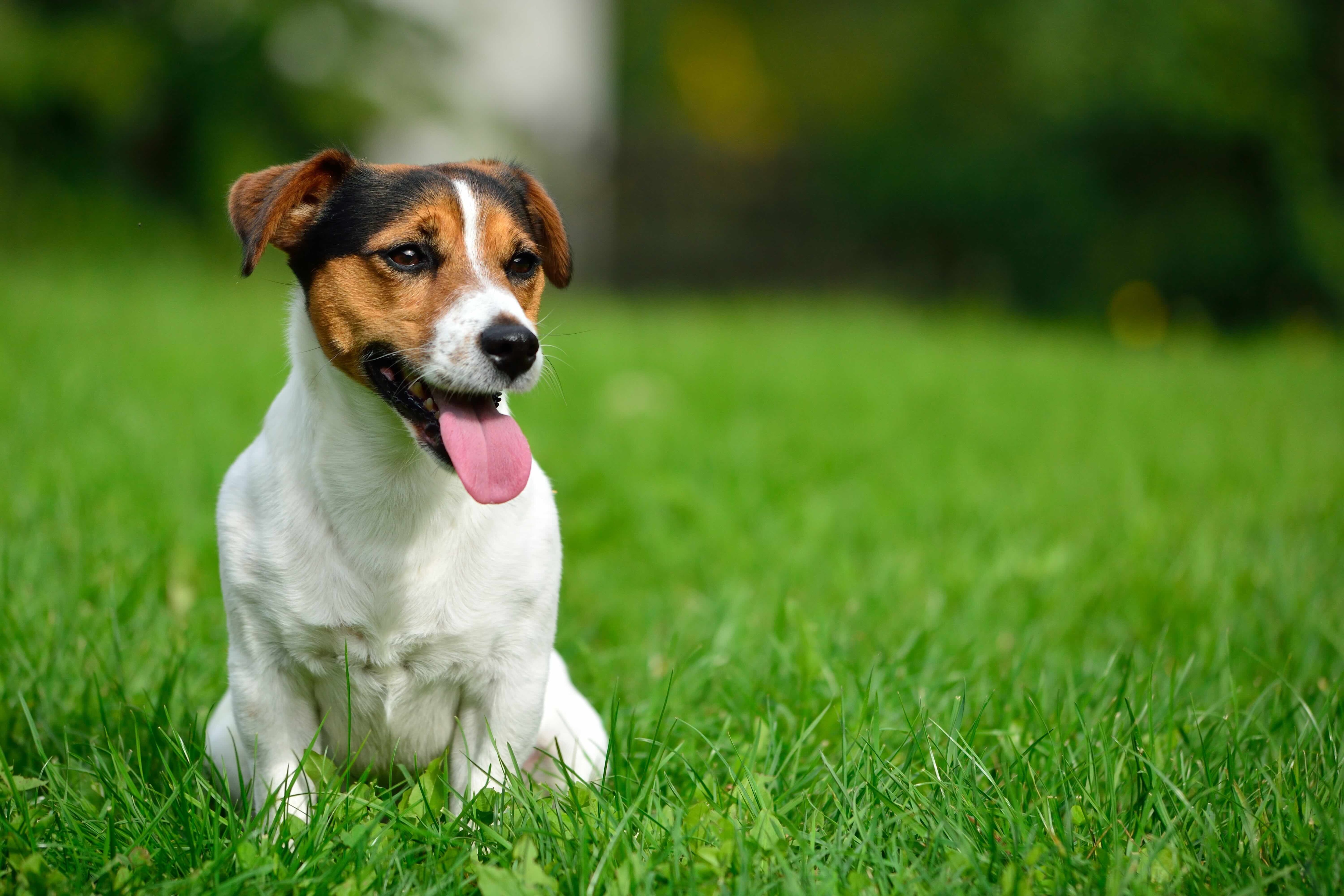Russell Terrier
helena babanova/iStock / Getty Images Plus via Getty Images
The Russell Terrier—not to be confused with their similar-but-separate relative, the Parson Russell Terrier—is a breed that’s small only in stature. In cleverness, alertness, and boldness (among other traits), the Russell is off the charts.
The Russell Terrier dog breed traces their beginnings to 19th-century England when a reverend named John Russell (nicknamed The Sporting Parson) created two distinct lines from his fox-working dogs. These later developed into both the Russell and Parson Russell (also called the Jack Russell) Terriers.
Though they share many similarities and began as the same breed, Russells are slightly shorter and more rectangular in shape. Parson/Jack Russell Terriers are taller and squarer in shape.
Everything about the Russell Terrier dog is ideal for his original fox-hunting duties, including the breed’s lively, fearless temperament. Their compact size (10–12 inches tall and 9–15 pounds) allowed them to be easily carried on horseback and to fit into underground tunnels when rooting out game.
Their talented noses would lead the way, and their boisterous bark would both alert their human companions and send their prey running into the open. Finally, the Russell’s weatherproof coat—which may be smooth, rough, or broken (between smooth and rough)—requires very little hands-on time and attention.
Caring for a Russell Terrier

Though bred for work, Russell Terriers can flourish as family companions under the right conditions.
Because of their chart-topping energy level and higher-than-average mental and physical stimulation needs (these high-energy dogs need at least 90 minutes to two hours of exercise every day), Russells do best with active families who have experience training brainy breeds. Affectionate and playful, Russells can get along great with kids who are old enough to safely and respectfully play with a tiny, zealous pup.
Homes with room to run outside are ideal. Because of their high prey drive, outdoor time should always be spent either on a leash or within a securely fenced area. That prey drive is also why Russell Terriers don’t make great companions for cats.
They can, however, thrive in homes with other dogs, as they were bred to work in groups. Just keep in mind that older, laid-back dogs may not be thrilled to have to accommodate such a high-strung sibling.
While you may wear yourself out exercising and entertaining your Russell, grooming is comparatively breezy. Their white coats require attention about once a week to stay healthy and clean.
Russell Terrier Health Issues
The Russell Terrier is a generally healthy breed with a life expectancy of 12–14 years. Still, like all breeds, they are predisposed to certain health conditions.
Patellar Luxation
When the patella (kneecap) moves outside its normal groove within the femur (thigh bone), this is called patellar luxation (dislocation). It’s one of the most common orthopedic conditions in small and medium-sized dogs and is particularly common in Russells.
Signs of patellar luxation include:
-
Limping
-
A popping or cracking knee joint
-
A bunny-hopping or skipping gait
-
Kicking legs out behind them often, especially when exercising
The condition can be mild and managed medically with help from your veterinarian, but severe cases may require surgery.
Congenital Deafness
Russell Terriers have mostly white coats, and dogs with white fur are more likely to carry genes that cause a malformation of the ear that results in deafness in one or both ears.
With some adjustments and training, dogs with hearing loss can live long, happy lives.
Primary Lens Luxation
Primary lens luxation (PLL) is a condition in which the eye lens moves out of its normal position. It can affect one or both eyes, and dogs with PLL may have eyes that are red, teary, cloudy, and painful.
PLL can also cause inflammation, glaucoma, and blindness if left untreated. If caught early, the condition can be managed and corrected with medications and surgery.
Periodontal Disease
Periodontal disease, or dental disease, is a progressive condition in which bacteria accumulate in the mouth and cause damage to the dog’s teeth, gums, jaw bones, and other tissues. While the disease is common in all dogs, small and toy breeds are especially prone to the problem.
Signs of periodontal disease include:
-
Bad breath
-
Missing and/or loose teeth
-
Root exposure
-
Bleeding gums
-
Excessive drooling
-
Swelling under the eye or on the cheek
The best way to prevent periodontal disease is through regular toothbrushing at home and professional dental cleanings at your vet’s recommendation. Dental chews can also help, but they aren’t a replacement for brushing your dog’s teeth.
What To Feed a Russell Terrier

When it comes to feeding your Russell Terrier, work with your veterinarian to develop a feeding plan that’s nutritionally complete and balanced for your pup’s age, weight, and health. Your vet can direct you to formulas approved by the Association of American Feed Control Officials (AAFCO).
How To Feed a Russell Terrier
Russell Terrier puppies have high metabolisms and need frequent meals (about three or four a day) to prevent low blood sugar. Full-grown Russells can be fed less frequently—typically two or three times a day. Ask your vet about the best schedule for your dog’s age.
How Much Should You Feed a Russell Terrier?
The right amount of food depends on your pup’s weight, body condition score, lifestyle, and health needs.
The nutrition label on your dog’s food bag includes a feeding guide that gives a general idea of how much you should feed your Russell, based on their weight. But for a better recommendation tailored to your own dog, ask your veterinarian.
Despite their lively lifestyle, small dogs like Russell Terriers can put on extra weight fast. Because of this, remember to factor treats into their daily calorie requirements. Treats should never make up more than 10% of your dog’s diet.
Nutritional Tips for Russell Terriers
If your Russell Terrier is eating a dog food approved by the AAFCO, they’ll receive all the nutrition they need. However, your veterinarian may recommend nutritional supplements or even a prescription diet, depending on your dog’s medical or physical needs.
Always talk to your veterinarian before giving your dog a supplement.
Behavior and Training Tips for Russell Terriers
Russell Terrier Personality and Temperament
The Russell Terrier’s temperament is a testament to the breed’s original working dog purpose—and for those wanting a family pet instead of a fox-hunting companion, this fact shouldn’t be ignored. This tiny bundle of energy has a brain and body that doesn’t stop—at least not until they’ve had plenty of mental stimulation and exercise.
But despite being built for work, Russell Terriers are also playful and affectionate. They can get along well with other dogs and with children who are old enough to safely interact with a dog as little and lively as the Russell.
Due to their high prey drive, however, Russells and cats are unlikely to peacefully coexist unless introductions are done properly when your Russell is a puppy.
Russell Terrier Behavior
Some of the Russell Terrier’s field talents—digging, barking, and chasing small animals—can be problematic in the home environment. And bored, lonely Russells with energy to spare will be more likely to engage in these unwanted behaviors.
It’s important to keep your Russell Terrier dog worn out, entertained, and well-trained. And while consistent training can reduce the frequency of undesirable behaviors, it’s unlikely that a Russell will never bark or dig.
Russell Terrier Training
Introduce your Russell Terrier puppy to new people, animals, and environments at a young age. Proper socialization is key for this breed (and all dogs) to be comfortable and confident in a variety of settings. Ideally, this should begin within the first 16 weeks of your puppy’s life.
While consistent training can reduce the frequency of undesirable behaviors, it’s unlikely that a Russell will never bark or dig.
Russell Terriers need early, consistent training to help curb some of their unwanted behaviors like barking and digging. And while their smarts make them quick learners, Russells can also bore easily.
Keep training fun by using a positive, rewards-based approach. This has a triple benefit of teaching necessary skills, building the human-animal bond, and providing mental and physical exercise.
Fun Activities for Russell Terriers
Russell Terrier Grooming Guide
While all Russell Terriers have weatherproof coats consisting of an undercoat and a harsh outer coat, their fur can differ in texture and length. Some are smooth, some are rough, and others are described as broken (somewhere between smooth and rough).
Regardless of categorization, all Russell Terriers are considered low-maintenance when it comes to grooming, though their needs differ according to coat type.
Skin Care
Russell Terriers don’t require special skin care. Ask your veterinarian how often you should bathe your dog.
Coat Care
Smooth-coated Russell Terriers benefit from a session with a soft brush around once a week. Rough- and broken-coated Russells need a weekly brushing or combing to keep their fur in fine shape.
Eye Care
The Russell’s dark, expressive eyes are prone to issues such as primary lens luxation. Schedule a vet appointment if you notice signs of disease like redness, cloudiness, or pain.
Ear Care
Ask your veterinarian for tips on how to safely clean your Russell Terrier’s ears. They can recommend a consistent cleaning schedule and ear cleaning products to use.
If you notice signs of an ear infection (redness, swelling, pain, or bad odor), it’s time to make a vet appointment.
Considerations for Pet Parents

Here are some questions to consider before adding a Russell Terrier puppy to your family:
-
Can I provide a high-energy dog with copious amounts of daily mental and physical exercise?
-
Can I keep a dog with a high prey drive safe (on a leash or within a fence) when outdoors?
-
Am I home enough to give a dog companionship?
-
Do I have the skills to consistently train a dog using positive reinforcement?
-
Do I have the patience to work with a dog that is prone to digging and barking?
-
Can I brush a dog’s teeth at least three times a week?
-
Am I financially prepared to provide veterinary care?
-
Can I provide a dog with a loving home for their lifetime, which could be 14 years or more?
If you can answer these questions with an enthusiastic “Yes!” you may be ready to parent a Russell.
Russell Terrier FAQs
Is a Russell Terrier the same as a Jack Russell?
Russell Terriers and Parson Russell Terriers (commonly called Jack Russell Terriers) are descendants of the same fox-working dogs but are distinct breeds. Though similar, Russell Terriers are different than Jack Russells.
Are Russell Terriers good dogs?
Russell Terriers are bright, boisterous dogs with brains and energy to spare. They can make excellent companions in highly active families, and in homes where they have room to run and play outside.
Do Russell Terriers bark a lot?
Yes, Russell Terriers tend to bark a lot due to their working dog history. Their vocal talents were an asset to fox hunts but are less popular in homes. Early, consistent training can help curb the noise, but prospective parents should prepare for a more talkative pet.
What’s the difference between Russell Terriers and Parson Russell Terriers?
The Parson Russell Terrier and Jack Russell Terrier are the same breed. Russell Terriers, however, are a separate breed, though they share common ancestors. The most notable differences between the two come down to size and shape: Parson Russell Terriers are taller, and shaped like squares, whereas Russell Terriers are more rectangular.
